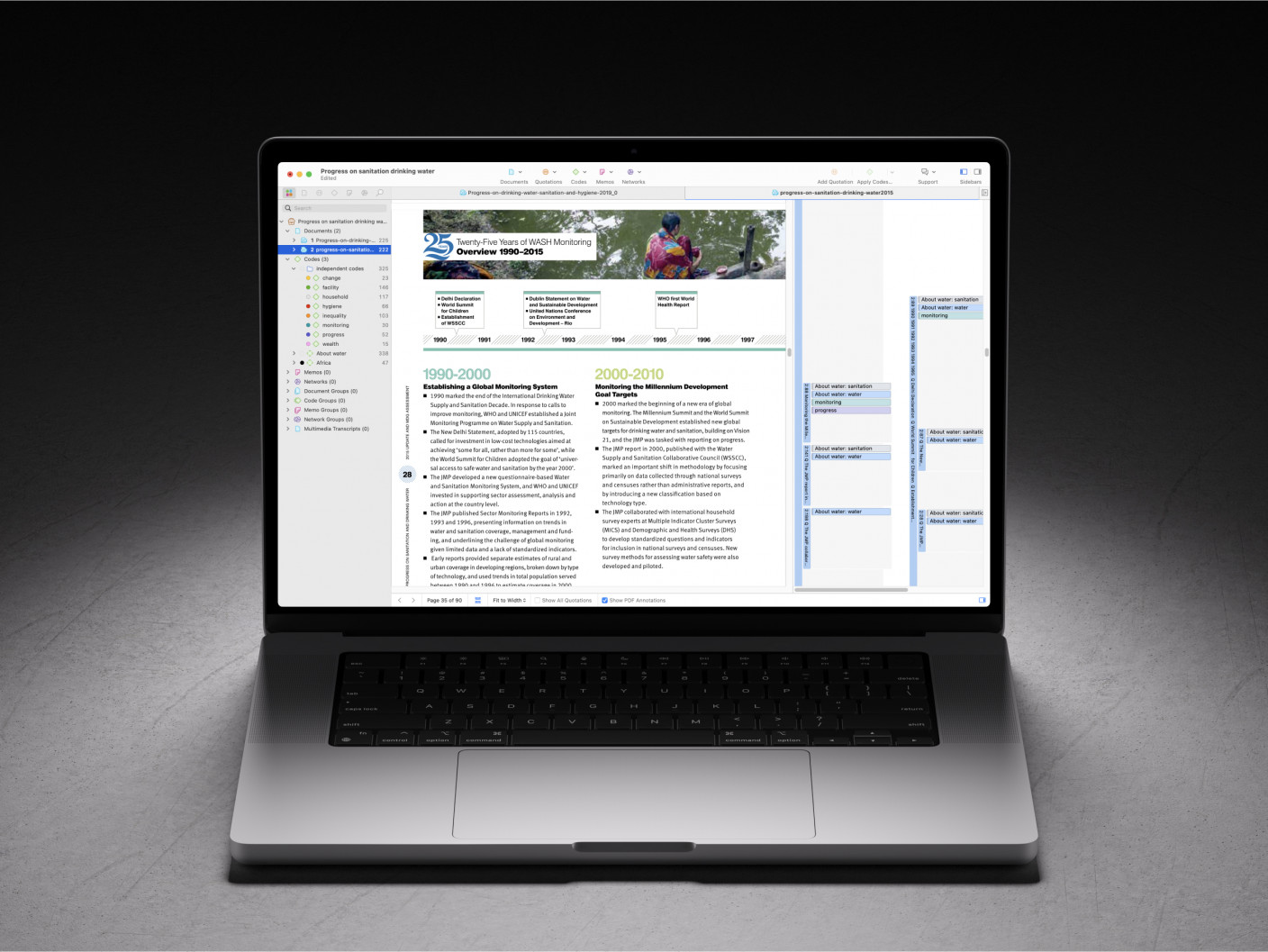- What is Mixed Methods Research?
- Advantages of Mixed Methods Research
- Challenges in Mixed Methods Research
- Common Mistakes in Mixed Methods Research
- Mixed Methods Research Paradigms
- Validity & Reliability in Mixed Methods Research
- Ethical Considerations in Mixed Methods Research
- Mixed Methods vs. Multiple Methods Research
- Mixed Methods Research Designs
- How to Choose the Right Mixed Methods Design
- Convergent Parallel Design
- Explanatory Sequential Design
- Exploratory Sequential Design
- Embedded Mixed Methods Research Design
- Transformative Mixed Methods Design
- Multiphase Mixed Methods Research Design
- How to Conduct Mixed Methods Research
- Sampling Strategies in Mixed Methods Research
- Data Collection in Mixed Methods Research
- Triangulation in Mixed Methods Research
- Data Analysis in Mixed Methods Research
- How to Integrate Quantitative & Qualitative Data?
- How to Interpret Mixed Methods Research Findings?
- Software Tools for Mixed Methods Data Analysis
- How to Write a Mixed Methods Research Proposal
- How to Write a Mixed Methods Research Paper?
- Reporting Results in Mixed Methods Research
- Mixed Methods Research Examples
- How to cite "The Guide to Mixed Methods Research"
How to Choose the Right Mixed Methods Design
Researchers need to choose a design that fits their research question. Understanding the principles and key decisions behind different mixed methods research approaches can help researchers choose the most suitable framework. In this article, we will cover the key elements and decisions a researcher can consider make when starting mixed methods research.

Introduction
Well-designed procedures are the foundation of quality research. For mixed methods research, researchers must choose a design that fits their research question, helps keep the project manageable, and provides a guiding framework for applying the methods. A common challenge is the temptation to combine elements of multiple designs, but focusing on a single design simplifies implementation and enhances clarity. The research question should be the primary consideration when selecting a mixed methods design. Researchers need to assess their expertise and identify gaps in their skills in qualitative or quantitative methods. If there are gaps, it's best to collaborate or choose a less demanding design. Available resources, such as time, funding, and team support, also influence the choice of design. There are three aspects to design decisions: data collection, timing, and integration of the two sets of data. Visual tools such as decision trees can help navigate these decisions, making it easier to define and implement an appropriate mixed methods approach.
How to choose the right mixed methods design?
Once researchers determine that their problem requires a mixed methods approach, they must select a design that aligns with their research questions. Understanding the principles and key decisions equips researchers to choose the most suitable framework. In this article, we will cover the key elements and decisions a researcher should take when embarking on mixed methods research.

Introduction
Well-designed procedures are the foundation of quality research. For mixed methods studies, researchers must choose a design that fits their research question, helps keep the project manageable, and provides a guiding framework for applying the methods. A common challenge is the temptation to combine elements of multiple designs, but focusing on a single design simplifies implementation and enhances clarity. The research question should be the primary consideration when selecting a mixed methods design. Researchers need to assess their expertise and identify gaps in their skills in qualitative or quantitative methods. If there are gaps, it's best to collaborate or choose a less demanding design. Available resources, such as time, funding, and team support, also influence the choice of design. There are three aspects to design decisions: data collection, timing, and integration of the two sets of data. Visual tools such as decision trees can help navigate these decisions, making it easier to define and implement an appropriate mixed methods approach.
Principles of mixed methods designs
Designing mixed methods research studies is a complex process, because mixed methods designs integrate both quantitative and qualitative research. Each mixed methods study is unique, but researchers follow key principles to navigate the process. These include determining whether the design is fixed or emergent, choosing an appropriate design approach, ensuring the research design aligns with the research problem, and clearly stating why mixed methods are necessary.
Recognizing fixed and emergent mixed methods designs
Mixed methods designs can be fixed, emergent, or a combination of both (Creswell & Plano Clark 2006):
Fixed mixed methods designs – These are planned at the start of the research process. Researchers determine in advance how qualitative and quantitative data will be used, collected, and analyzed.
Emergent mixed methods designs – These are iteratively developed during the research process. Researchers may initially plan to use only qualitative or quantitative methods but realize later that another method is needed. For example, if quantitative findings lack clarify, researchers may add a qualitative phase to enrich the insights.
Most mixed methods studies exist along a continuum rather than fitting neatly into fixed or emergent categories. Some designs start as fixed but incorporate emergent elements, such as refining the second phase of data collection based on the results of the first phase.
Identifying an appropiate design
Researchers also use different approaches when designing mixed methods studies. Two main categories are:
Typology-based approach – This approach classifies mixed methods designs into predefined types based on established frameworks. Researchers choose a design that aligns with their research purpose and questions. Scholars like Creswell and Plano Clark have developed typologies that help guide researchers in structuring mixed methods studies.
Dynamic approach – This focuses on adapting the research design as needed. Rather than selecting a fixed design type, researchers interconnect multiple components such as the research purpose, conceptual framework, research questions, and methods. A dynamic approach allows researchers to modify their design as they analyze data.
Some scholars, like Hall and Howard (2008), advocate a synergistic approach, which combines both typological and systematic methods. This approach suggests that mixed methods research should not just combine qualitative and quantitative elements but create a stronger, more integrated design.
Matching the design to the research problem, purpose, and questions
Regardless of the chosen approach, the research problem, purpose, and questions should determine the appropriate mixed methods design. Research questions often emerge from:
- Gaps in existing literature
- Unanswered questions from previous studies
- Unexplained findings from initial research
- The need to enhance study validity
Matching the design to the research question ensures that the selected methods effectively address the study's objectives. For example, a researcher might choose a sequential exploratory design if they need to explore a new phenomenon qualitatively before testing their findings quantitatively.
Being explicit about the reasons for mixing methods
Mixed methods research requires a clear rationale for integrating quantitative research and qualitative research. Researchers should justify their choice by identifying specific reasons for using mixed methods research. Common reasons include:
- Triangulation – Using multiple methods to confirm findings.
- Complementarity – Enhancing understanding by combining different perspectives.
- Development – Using one method’s findings to inform the next phase.
- Initiation – Uncovering contradictions that require further exploration.
- Expansion – Broadening the scope of research by integrating diverse methods.
Bryman (2006) expanded on these categories and listed 16 different reasons why researchers mix methods. These reasons often overlap, and researchers may adapt their approach as new insights emerge.
Considerations when choosing a design
Selecting a core mixed methods research design requires careful attention to specific factors that shape the study’s structure and outcomes. The key considerations include:
Intent of the design
The intent behind mixing methods is the most critical factor. Researchers must clarify whether the goal is to compare, explain, or explore phenomena. For instance, a convergent design is ideal for comparing qualitative and quantitative results, while an explanatory sequential design is suited for explaining quantitative findings with qualitative insights. An exploratory sequential design works best when qualitative research informs subsequent quantitative phases.
Familiarity with designs in the field
The prevalence of certain mixed methods research designs within a discipline can influence the choice. Some fields, like global health, often prefer exploratory sequential designs due to cultural considerations, while trauma research may lean toward explanatory sequential designs. Reviewing established practices ensures the design aligns with disciplinary norms and expectations.
Expertise of the researcher
The researcher’s skill set plays a vital role. Those with strong quantitative backgrounds might prefer explanatory sequential designs, which begin with quantitative data. Conversely, researchers with qualitative expertise may gravitate toward exploratory sequential designs. For studies requiring both skill sets, collaboration within a mixed methods team can enhance the study's rigor and depth.
Time available to conduct the study
Time constraints significantly affect design choice. Sequential designs, whether explanatory or exploratory, typically require more time due to their multi-phase structure and need for separate qualitative data collection and quantitative data collection. In contrast, convergent designs allow for simultaneous data collection, making them more time-efficient when quick results are needed.
Complexity of the design
Design complexity varies based on the number of phases and procedures involved. Convergent designs, though conducted in a single phase, can be complex due to the need for data integration. Sequential designs add layers of complexity by requiring clear connections between phases. Researchers should balance the study’s objectives with their capacity to manage these complexities.

Key decisions for choosing a mixed methods design
- Level of interaction: Determining whether the quantitative and qualitative strands will be independent or interactive. Independent strands are kept separate until the final interpretation, while interactive strands influence each other throughout the study.
- Priority or weight: Deciding whether to give equal weight to both methods or prioritize one over the other based on the research goals.
- Timing: Choosing between concurrent data collection (collecting both data types simultaneously), sequential collection (one follows the other), or a multiphase combination (involving multiple stages over time).
- Mixing strategies: Identifying how and when to integrate the data. This can occur during data collection, analysis, or interpretation through strategies like merging datasets, connecting results from one phase to another, embedding one method within another, or using a theoretical framework to guide integration.
Level of interaction
When using mixed methods research, you need to decide how much the quantitative and qualitative parts of your study will interact. This means choosing whether to keep them separate or to connect them at different stages. There are two main ways to handle this: keeping them independent or making them interactive.
- Independent approach: In this setup, the quantitative and qualitative parts are kept separate. You collect and analyze the data for each method independently, without them influencing each other. The only time they are combined is at the end, when you interpret the results.
- Interactive approach: Here, the two methods are connected at different points in the study. One method may depend on the results of the other, or data from one may be converted into the other type for joint analysis. You may also use one method within a framework based on the other. This allows for more integration throughout the research process rather than just at the conclusion
Weighting
Weighting in mixed methods research refers to the emphasis or priority assigned to qualitative or quantitative research methods in a study to address the research questions effectively. This decision, often called the "priority decision" (Morgan, 1998), involves determining whether the methods should carry equal importance or whether one should be prioritized over the other.
Researchers have two main weighting options: assigning equal weight to qualitative and quantitative methods or weighting them unequally. When methods are equally weighted, both play crucial roles in addressing the research problem. If they are weighted unequally, one method is emphasized more to better suit the study's goals, such as an emphasis on qualitative analysis for exploring complex phenomena or a quantitative focus for generalizability.
Selecting an appropriate weighting involves considering theoretical frameworks and practical constraints. Some researchers say that a study's philosophical orientation—post-positivist, naturalist, or pragmatic—can guide the weighting choice. Pragmatism often allows flexibility in weighting based on the research questions. Additionally, the methodological tradition, such as quantitative experiments or qualitative case studies, influences the decision.
Practical factors such as resource availability, the researcher's methodological expertise, and the preferences of the intended audience (e.g., journal editors or funding agencies) also play a role. Limited resources may necessitate prioritizing one method over another.
In mixed methods research reports, indicators of weighting include:
- The wording of the title: The inclusion of quantitative or qualitative terms signals unequal weighting, while the absence of such terms suggests equal weighting.
- Clear identification of the guiding worldview used in the study.
- A purpose statement that highlights unequal weighting with phrases like "primary aim" or "secondary purpose."
- A declaration of the weighting is provided in the methods section.
- Greater emphasis on one method through the allocation of more space in the article or abstract.
- The use of more advanced and detailed procedures for one method compared to the other.
Effective weighting enhances the research study's capacity to address complex research problems by leveraging the complementary strengths of qualitative and quantitative methods.
Timing
When designing a study, it is recommended that researchers ask themselves what the timing, implementation, or sequence of the quantitative and qualitative approaches will be. This refers to the temporal relationship between the components within a study, including the time at which the datasets are collected and the order in which the researchers use the data. Thus, timing relates to both data collection and analysis, and it can be concurrent or sequential:
Concurrent: This refers to when the researcher implements quantitative and qualitative methods during a single phase of the research study. This means that the qualitative and quantitative components are collected, analyzed, and interpreted at (approximately) the same time.
Sequential: This refers to when the researcher implements the methods in two distinct phases, collecting and analyzing one type of data first, and then collecting and analyzing the other data type. It is important to choose which strand comes first, enabling researchers to harness insights from one to inform the other. For instance, the qualitative component may guide how quantitative data should be collected or it may expand understanding of quantitative data that was already collected.
Mixing
In mixed methods research, the integration of quantitative and qualitative strands is essential for developing a comprehensive understanding of a research problem. Researchers must decide when and how to combine these approaches to ensure coherence and enhance the study’s quality. This integration process, referred to as mixing, combining, or integrating, determines the relationship between the study’s quantitative and qualitative elements. Two important concepts guide this process: the point of interface and mixing strategies.
The point of interface
The point of interface, also called the stage of integration, refers to when in the research process the quantitative and qualitative strands are brought together. Researchers can integrate these strands at four main points: interpretation, data analysis, data collection, and design. The choice of where to mix depends on the study’s objectives, structure, and the extent to which the two strands interact. Some studies keep the strands independent throughout the research process, only integrating them at the interpretation stage, while others combine them at multiple points for a more interconnected approach.
Mixing during interpretation
Mixing during interpretation occurs at the final stage of the research process, after both quantitative and qualitative data have been collected and analyzed separately. At this stage, researchers draw conclusions by synthesizing findings from both strands, identifying relationships, and making comparisons. This process allows the researcher to develop a more nuanced understanding of the research question by considering multiple perspectives. If the study maintains independent quantitative and qualitative strands throughout, the interpretation stage may be the only point at which the two are mixed. For example, a study investigating student performance might analyze test scores quantitatively while using qualitative interviews to explore study habits, ultimately combining the findings to identify patterns in learning behaviors.
Mixing during data analysis
Mixing during data analysis occurs when the researcher integrates the quantitative and qualitative strands at the stage of analyzing the collected data. This involves first conducting separate analyses for each strand and then merging the results through an interactive strategy. One way to do this is by creating a matrix that facilitates comparisons between the two data types. Another approach involves transforming one type of data into another; for example, qualitative themes may be quantified to allow statistical analysis, or numerical findings may be interpreted narratively. This method of integration allows researchers to develop deeper insights by comparing patterns across data types. A study on workplace satisfaction, for instance, may statistically analyze survey responses while also conducting thematic analysis on interview transcripts to explore employees’ experiences in more depth.
Mixing during data collection
Mixing during data collection occurs when the results of one method influence the collection of data for the other. This approach, known as connecting, involves using findings from one strand to guide the next phase of data collection. The researcher might first conduct a quantitative survey and use the results to shape the design of qualitative interviews, selecting participants based on specific survey responses. Conversely, qualitative findings might inform the development of a follow-up quantitative questionnaire. This approach creates a logical sequence in data collection, allowing the researcher to explore specific topics in greater depth. For example, in a health study, initial survey responses might indicate a trend in patient experiences, prompting targeted qualitative interviews to understand the reasons behind these patterns.
Mixing at the level of design
Mixing at the level of design occurs when quantitative and qualitative strands are integrated into the study’s overall structure. This form of integration is particularly useful for embedding one method within another, incorporating theoretical frameworks, or aligning multiple studies within a broader research program. Researchers often employ three main strategies at this level: embedded mixing, theoretical framework-based mixing, and program-objective mixing.
Embedded mixing involves incorporating a smaller qualitative or quantitative component within a larger research design. For example, a clinical trial may primarily rely on quantitative methods but include qualitative interviews to gather additional context. Theoretical framework-based mixing integrates both strands within a guiding theoretical perspective, such as a feminist or social science framework, ensuring the mixed methods approach aligns with a broader conceptual foundation. Program-objective mixing occurs when the research is part of a larger, multi-phase study where quantitative and qualitative elements contribute to achieving overarching program goals. For instance, a public health intervention might integrate multiple mixed methods studies to evaluate different aspects of the program’s effectiveness over time.
Conclusion
Selecting the appropriate mixed methods design is a critical step in conducting rigorous and meaningful research. This process involves key decisions such as determining whether the design will be fixed or emergent, deciding on the sequence and priority of qualitative and quantitative data, and identifying how to integrate findings effectively. Researchers must also consider how the design aligns with their research questions, purpose, and the nature of the data they plan to collect. After choosing the design, researchers shift their focus to the next steps: defining precise research questions, selecting suitable sampling strategies, and determining data collection methods that fit the chosen approach. They also plan how to analyze and integrate qualitative and quantitative data to draw comprehensive conclusions. This stage ensures the research is methodologically sound and positioned to generate meaningful insights.
References
- Creswell, J. W., & Plano Clark, V. L. (2006). Designing and conducting mixed methods research (2nd ed.). SAGE Publications.
- Morgan, D. L. (1998). Practical Strategies for Combining Qualitative and Quantitative Methods: Applications to Health Research. Qualitative Health Research, 8(3), 362–376.
- Bryman, A. (2006). Integrating quantitative and qualitative research: How is it done? Qualitative Research, 6(1), 97–113
- Hall, B., & Howard, K. (2008). A synergistic approach: Conducting mixed methods research with typological and systemic design considerations. Journal of Mixed Methods Research, 2(3), 248–269


